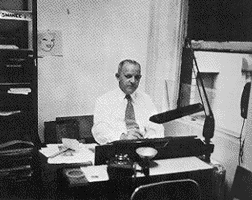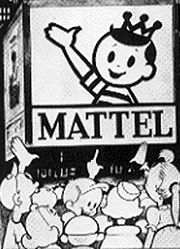The Electric Felix Man
by John Canemaker
 Messmer
at his desk at Douglas Leigh Organization. Courtesy Doris Messmer
Messmer
at his desk at Douglas Leigh Organization. Courtesy Doris Messmer
Otto Messmer was a lucky man.
True, he never received screen credit on the more than 150 Felix the Cat cartoon
shorts he directed during the 1920s. Producer Pat Sullivan saw that only his
name accompanied Felix's on the screen.
It is also true that Messmer never received a cent of the lucrative royalties
generated from licensing the Cat's image to an international array of merchandisers;
along with accolades from Felix fans around the world, Sullivan also happily
accepted all the licensing loot.
And it is true that Messmer never owned the copyright to the famed cartoon
Cat he created in 1919 and to whom he gave a distinctive personality that
profoundly inspired the character animators who followed, including Walt
Disney. A deathbed promise from Sullivan that ownership of the character
would pass from him to Messmer proved untrue.
 Messmer (left) discussed with Don Leigh a storyboard for a giant
animated electric sign. Courtesy Doris Messmer
Messmer (left) discussed with Don Leigh a storyboard for a giant
animated electric sign. Courtesy Doris Messmer
Yet, Messmer considered himself a lucky man. A shy artist, he often stated
that he felt fortunate to work all day at his drawing board as a "salaried
man," shielded by Sullivan from the high pressure, aggressive domain
of film business deals and product promotion. Messmer's gift lay in dreaming
up brilliant visual gags and imaginative stories for Felix, and gently
(but authoritatively) supervising the small team of animators who assisted
him in making one film every two weeks. If forfeiture of fame and riches
was the price to be paid for enjoying a decade of intensely personal creative
expression, Messmer considered it to be more than a fair exchange.
When the Felix studio died with Pat Sullivan in 1933, Messmer unhappily
wandered Felix-less to other cartoon studios. In 1936, the Van Buren Studio
acquired rights from Sullivan's heirs to make three sound-and-Technicolor
Felix shorts. Messmer was asked to direct but he wriggled out of the assignment.
After years of devising pantomimic performances for a simple ink blot character,
Messmer may have felt insecure about his ability to make toons using the new
technology of soundtracks and color. Less was always more when Messmer animated
Felix; his silent black and white drawn world was so direct, simple and pure,
it seemed like cinematic haiku.
Messmer continued to draw the Felix comic books, but his film directing
days seemed to be over. Then, in 1937, his luck again came to the fore
when he was hired by Douglas Leigh, the "Sign King" or "Lamplighter
of Broadway," the man behind the construction of huge animated electric
signs that illuminated Times Square and other urban spaces around the globe.
For the next 37 years until his retirement in 1973, Messmer designed and
directed characters and moving graphics for the Leigh-EPOK Spectacular,
described by Leigh as "an oversized advertising display with neons
or lamps in unusual animations."
 An advertisement for Mattel Toys, drawn by Otto Messmer,
one of the many clients using Leigh-EPOK animated electric signs. Courtesy
Doris Messmer
An advertisement for Mattel Toys, drawn by Otto Messmer,
one of the many clients using Leigh-EPOK animated electric signs. Courtesy
Doris Messmer
Otto and EPOK were a miraculous match. Here was work that was incredibly similar
to what Messmer did when he first joined the Sullivan studio nearly a quarter
century before: dreaming up silent visual gags for black-silhouetted personality-driven
characters. Working essentially alone, with only an assistant to blacken in
the drawings, Messmer was again a salaried man shielded from bothersome business
details by a strong entrepreneur. Leigh, like Sullivan, paid him a weekly
salary for anonymously creating lively cartoons that would be seen and enjoyed
by a worldwide audience.
It is amusing and somewhat touching to note that in 1937, while Messmer
was enjoying a giant leap backward in animation technique and aesthetics,
Walt Disney was premiering his first feature-length cartoon Snow White
And The Seven Dwarfs.
John Canemaker is a filmmaker and animation historian. He heads the animation
program at New York University and his books include Before Animation
Begins: The Art and Lives of Disney Inspirational Sketch Artists (Hyperion),
Tex Avery: The MGM Years (Turner), and Felix: The Twisted Tale of
the World's Most Famous Cat (Da Capo).
© John Canemaker
Back to the Table of Contents
Feedback?
Past Issues
![]()
![]()
![]()
![]()
![]()
![]()
[about | help
| home | info@awn.com
| mail | register]